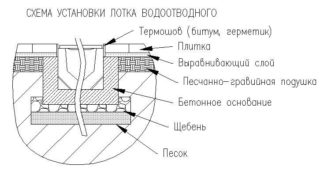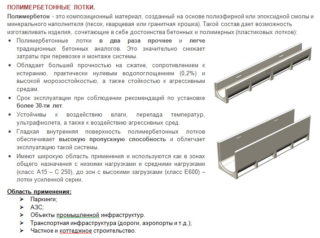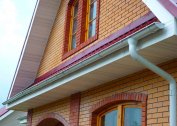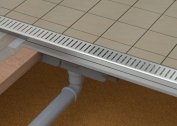As the main element of storm sewers use trays. Gutters are made of polypropylene, low-pressure polyethylene, reinforced concrete and stone chips with polymer impurities. The latest version of the products is popular because of the total weight and optimal technical characteristics. Rates for polymer-concrete drainage trays with gratings vary depending on the dimensions: the length of the section, its hydraulic section, the width and height of the sides.
Scope of polymer-concrete drainage trays
As well as concrete / plastic gutters, polymer concrete trays are produced strictly according to GOST. As a result, the products combine the strength of stone and the plasticity of polymers. Such gutters are used in the following areas:
- installation of a drainage system on private plots;
- stormwater installation at urban sites: parks, paths, transport roads;
- installation of a drainage system at gas stations, car washes;
- arrangement of channels for the removal of rainwater and polluted effluents in the zone of industrial enterprises.
Due to its high strength, polymer concrete is able to withstand a load of up to 25 tons. With large static and dynamic effects, the gutter is subject to deformation.
Gutter Specifications
During the production of polymer concrete gutters, special resins (often epoxy) are added to the mixture. They serve as an astringent instead of mineral additives (silicate, sand, etc.). As a result, the trays have the following technical characteristics:
- Classes of loads vary from A15 to C 250. This means that the gutters can withstand from 1.5 to 25 tons.
- Water absorption is almost 0.
- Hydraulic section - from 100 to 200 mm.
- Section length - as a rule, 1000 mm.
- Product width from 138 to 248 mm.
- The height of the sides is from 60 mm to 243 mm.
- The weight of the tray is from 6.3 kg to 13.4 kg.
The laying of polymer concrete gutters is not carried out in conditions of military bases, airports and other powerful facilities with a load of more than 25 tons.
Mounting Features
 Laying trays of polymer concrete is carried out according to this technology:
Laying trays of polymer concrete is carried out according to this technology:
- Prepare a trench under the stormwater device. Its depth is 10-15 cm greater than the height of the gutter. A margin of 5-7 cm is also left on the sides.
- The bottom of the channel is carefully compacted and covered with a layer of sand. It also needs to be tamped and leveled.
- As soon as the sand cushion is ready, a layer of concrete mixture 5-8 cm thick is poured onto the bottom of the canal. They wait until everything dries.
- Using the level or control thread stacking trays. They are joined together by the principle of groove in groove.
- The sides of the storm are poured with a solution of cement and sand. He will protect the sewer from soil heaving.
- Spray the channel and lay the protective grilles.
If storm sewers are laid in public places, slotted gratings are best chosen with a fixing system. This will ensure the safety of the metal from vandals.
Advantages and disadvantages of polymer concrete gutters
 Polymer concrete trays have the following advantages:
Polymer concrete trays have the following advantages:
- High strength. Due to the absence of mineral impurities, even point impacts for trays are less scary than for concrete products.
- Relatively light weight. A standard polymer concrete trench is two times lighter than a stone product.
- High compressive and tensile strength due to elastic resins added to the composition.
- Resistance to subzero temperatures.
- Inertness to aggressive substances in wastewater.
- The presence of a smoother inner surface, on which sludge and debris do not settle.Under this condition, it is much easier to clean the storm.
- The service life is from 30 years, provided that the sewer is properly installed.
For the device to work properly gravity rainfall it is important to correctly select the cross section of the gutters.
The cost of trays made of polymer concrete
The price of drainage gutters varies depending on the dimensions of the product. Approximate cost of products in Moscow and the region:
| product name | Length (mm) | Width (mm) | Height (mm) | Hydraulic section (mm) | Price, rub.) |
| Polymer concrete tray COMPOMAX BASIC | 1000 | 138 | 60 | 100 | 1290 rub |
| Polymer concrete tray COMPOMAX BASIC | 1000 | 138 | 125 | 100 | 2050 rub. |
| Polymer concrete tray COMPOMAX BASIC | 1000 | 243 | 93 | 100 | 3405 rub. |
| Polymer concrete tray COMPOMAX BASIC | 1000 | 138 | 100 | 100 | 1522 rub. |
When choosing gutters from polymer concrete, it is important to consider the amount of rainfall in the region. This will help to buy the gutters with the necessary throughput. When laying a storm shower, it is necessary to observe a bias towards the central highway or a private receiver (septic tank / pit).




